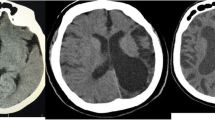Abstract
In six patients with apallic syndrome the EEG was isoelectric, although the patients were breathing spontaneously and vegetative functions remained stable for a long period of time. No cortical somatosensory evoked potentials could be recorded in four of the patients examined. Cranial CT performed in three patients revealed extensive hypodensity of the cortex, whereas the brain stem showed no major damage. This syndrome is labelled a “complete apallic syndrome”. None of our patients, and none of the 23 patients described in the literature, recovered.
Similar content being viewed by others
References
Amann E, Gerstenbrand F, Jellinger K (1971) Schwerer Hirnschaden (apallisches Syndrom) nach Herzstillstand bei einem Kleinkind. Padiatr Padol 6:121–134
Bennett DR, Nord NM, Roberts TS, Mayor H (1971) Prolonged “survival” with flat EEG following cardiac arrest. Electroencephalogr Clin Neurophysiol 30:94
Bennett DR, Hughes JR, Korein J, Merlits JH, Sutter C (1977) Atlas of electroencephalography in coma and cerebral death. Raven Press, New York
Bricolo A, Benati A, Mazzo C, Bricolo AP (1971) Prolonged isoelectric EEG in a case of post traumatic coma. Electroencephalogr Clin Neurophysiol 31:174
Brierley JB, Adams JH, Graham DI, Simpson JA (1971) Neocortical death after cardiac arrest. Lancet II:560–565
Brunko E, Zegers de Beyl D (1987) Prognostic value of early cortical somatosensory potentials after resuscitation from cardiac arrest. Electroencephalogr Clin Neurophysiol 66:15–24
Haupt FW, Schumacher A (1988) Medianus-SEP and Prognose in der neurologischen Intensivmedizin — Eine Studie an 255 Patienten. Z EEG-EMG 19:148–151
Ingvar D, Brun A (1972) Das komplette apallische Syndrom. Arch Psychiat 215:219–239
Ingvar D, Brun A, Johannsson L, Samuelson SM (1978) Survival after severe cerebral anoxia with destruction of the cerebral cortex: the apallic syndrome. Ann NY Acad Sci 315:184–214
Jonkman EJ (1969) Cerebral death and isoelectric EEG. Electroencephaogr Clin Neurophysiol 27:215
Leenstra-Borsje H, Boonstra S (1969) A restrospective investigation of the clinical symptoms and course of patients with complete or incomplete isoelectric EEG. Electroencephalogr Clin Neurophysiol 27:214–15
Mauguiere P, Desmedt JE, Courjon J (1983) New generators of N18 and P14 somatosensory evoked potentials studied in patients with lesions of thalamus or thalamo-cortical radiations. Electroencephalogr Clin Neurophysiol 56:283–292
Pollack NA, Kellaway P (1978) Cortical death with preservation of brain stem functions, correlation of clinical, electrophysiologic, CT-scan findings in 3 infants and two adults with prolonged survival. Transam Neurol Assoc 103:36–38
Schara J (1976) Die Grenzen der Behandlungspflicht in der Intensivmedizin. Dtsch Ärztebl 73:507–515, 587–591
Schuchardt V, Biniek R, Heitmann R (1984) Grenzen neurologischer Intensivmedizin. Intensivther Notfallmed 19:65–70
Schwartz BA (1970) Non existent or imperceptible EEG activity. Electroencephalogr Clin Neurophysiol 29:531
Trojaberg B, Jorgenson EO (1973) Evoked cortical potentials in patients with isoelectrical EEGs. Electroencephalogr Clin Neurophysiol 35:301–309
Author information
Authors and Affiliations
Rights and permissions
About this article
Cite this article
Biniek, R., Ferbert, A., Rimpel, J. et al. The complete apallic syndrome — a case report. Intensive Care Med 15, 212–215 (1989). https://doi.org/10.1007/BF01058577
Received:
Accepted:
Issue Date:
DOI: https://doi.org/10.1007/BF01058577




